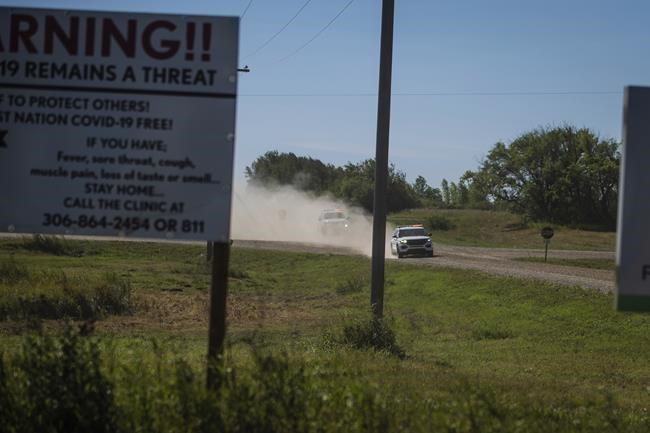The head of the First Nations Chiefs of Police Association says he hopes a federal bill in the works that aims to make Indigenous policing an essential service will come with adequate funding to ensure those forces can attract enough officers. Â
"It really impacts the recruiting and retention of employees when the chief of police can't categorically offer somebody a fulsome career in policing," said Lennard Busch, a former police chief and member of the Kahkewistahaw First Nation in Saskatchewan.
"So why wouldn’t they look somewhere else where they could be with … a larger police service, where their longevity is almost certain?"
Busch's association and the Assembly of First Nations has been working with Public Safety Canada on drafting the legislation, which is expected to be introduced in the new year.Â
Public Safety Minister Marco Mendicino said in an interview with The Canadian Press earlier this month that Indigenous communities deserve "the same quality of policing" as others.
"We need to anchor our work in a relationship that is based on trust, on respect and on a recognition of the inherent right of Indigenous Peoples to self-determine when it comes to public faith," Mendicino said.Â
The legislation has been years in the making, but the need for it was brought to the fore after a mass stabbing on James Smith Cree Nation, Busch said.
The Sept. 4 stabbings left 11 dead and 18 injured at the First Nation, as well as in the nearby village of Weldon, northeast of Saskatoon.
James Smith Cree Nation Chief Wally Burns has since pushed the federal government to help fund a policing service in his community.
The First Nation currently relies on RCMP, with the closest detachment nearly 50 kilometres away.
RCMP continue to patrol the community, and the First Nation has taken it upon itself to install security cameras and have members monitor the area.
Following the stabbings, Mendicino said the bill would be ready for the fall, but then delayed it.
"The consultation process that Indigenous people demand, it does take time," Busch said.
Across Canada, there are 36 First Nations or Inuit police services that are self-administered.
The bulk of them are in Quebec and Ontario, with one in Saskatchewan — the File Hills First Nations Police Service, of which Busch was the police chief until his retirement in 2021.
These self-administered police services are funded under the First Nations and Inuit Policing Program, which was created in 1991 as a way for the federal government to fulfil its treaty obligation related to policing and law enforcement.
In February, Public Safety Canada released a report that evaluated the program.
It found the program is chronically underfunded by the federal and provincial governments, hampering the ability of First Nations to develop and implement their own self-determined police services.
This has led to one-third of the self-administered First Nation police services disbanding since the program started in 1991, Busch said.
"If you have five or six members, and one retires, one quits and one gets sick, then you are in great jeopardy of not being able to deliver services," he said. "The recruitment of people is something that doesn’t happen overnight, either."
The Public Safety Canada report said Ottawa's current funding model is outdated and insufficient to address the public safety needs of First Nations.
Program data from the department shows that from 2004 to 2018, those communities experienced a 3.5 per cent increase in crime, while there was a 28.5 per cent decrease across other communities.
Over the same time period, rates of violent crime in communities with those policing agreements were found to have increased by nearly 32 per cent, while in the rest of Canada there was a nearly 16 per cent decrease.
With Indigenous people also overrepresented in the Canadian criminal justice system, federal government support for First Nations and Inuit policing should be maintained and strengthened, Public Safety Canada said in its assessment.
Busch said it's important for officers to be recruited from the community or the same cultural group that is being served.
"It allows you to build those relationships and to address some of the critical issues, social issues and crime issues in their communities in a more meaningful way and in an ongoing basis."
This report by The Canadian Press was first published Dec. 30, 2022.Â
Mickey Djuric, The Canadian Press



